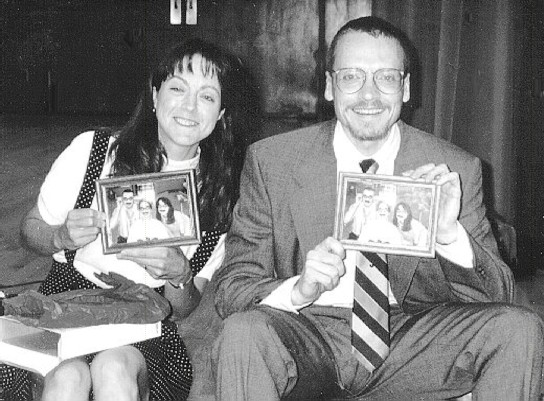
Therapists Bretta Hopkins and Arlen Carr. The pictures were a gift to Bretta and Arlen to commemorate the time during therapy when all three of us wore funny noses and glasses.
Snapshots by Gloria Freeland - April 4, 2002
Numb and Numb-er
Easter and spring - symbolic of new beginnings - remind me of my own new beginning five years ago this month.
My "adventure" began in January 1997, although I'd had symptoms off and on for a couple of months. At first I thought the severe headaches and extreme tiredness were related to the cold or virus I had picked up before the holidays. But I got weaker and started losing sensation in my extremities. It felt as if I was going to sleep an inch at a time, beginning with my hands and feet and progressing to the core of my body. Eventually I couldn't walk, talk, eat or even breathe on my own.
Initially doctors thought I had Lyme Disease, and then they thought it might be Guillain-Barré Syndrome, a disease where the body's own immune system strips nerves of their insulating fatty myelin. They made preparations for me to be transferred to St. Luke's Hospital in Kansas City, where I would undergo plasmapheresis, a process by which the blood is removed from the body, the white and red blood cells are separated out, the rest of the blood is thrown away, and the white and red blood cells are put back in.
At St. Luke's, the neurologist ruled out Guillain-Barré, stating I had better reflexes than many of her well patients. After spinal taps and hours of MRIs, she diagnosed me with "idiopathic encephalomyelitic polyneuritis" - a descriptive name stating what was happening. "Idiopathic" meant they didn't know what caused it, "encephalomyelitic" meant it affected the myelin in the brain stem and spinal cord, and "polyneuritis" just meant many nerves.
Giving it a name didn't make it any less scary. What was going to happen to my daughters, then 4 and 10, if I couldn't work, couldn't write, couldn't hold up books to read to them, couldn't walk?
My husband observed that it's not particularly good to be a unique medical case because doctors are accustomed to symptoms that follow certain patterns. From those patterns, they make diagnoses and then prescribe treatments. Since my condition didn't follow a pattern doctors were used to, all they could do was guess what might work. But the neurologist seemed confident of what to do and, luckily, she was correct. After massive doses of the steroid prednisone and many weeks of re-learning to walk, coordinate my hand movements, talk and eat, I finally got back to "normal," although my husband jokes that he doesn't think I ever was very normal.
Perhaps as important as the medical treatments was my husband's bizarre sense of humor. He made me laugh every day, and I believe the adage that laughter is good medicine.
The support of family and friends and the dedication of the doctors, nurses and therapists who worked with me also went a long way in the healing process.
Today, I have just a few residual effects from the illness - tingling in my hands and feet and a strange numbness in my trunk. Sometimes the tingling feels like I have sand between my toes and fingers. Those effects are just a gentle, daily reminder that I should be thankful for the simple things most of us take for granted - things like brushing my own teeth and hair, buttoning my shirts, tying my shoes, reading, writing this column - and even my own name, going up and down stairs, talking with friends, tasting food on my tongue, and hugging my loved ones.
In early April 1997, I was released from Kansas Rehabilitation Hospital in Topeka after my 12-week "adventure." I wouldn't want to repeat it. Still, I wouldn't want to give back what I gained from the experience either.

Therapists Bretta Hopkins and Arlen Carr. The pictures were a gift to Bretta and Arlen to commemorate the time during therapy when all three of us wore funny noses and glasses.